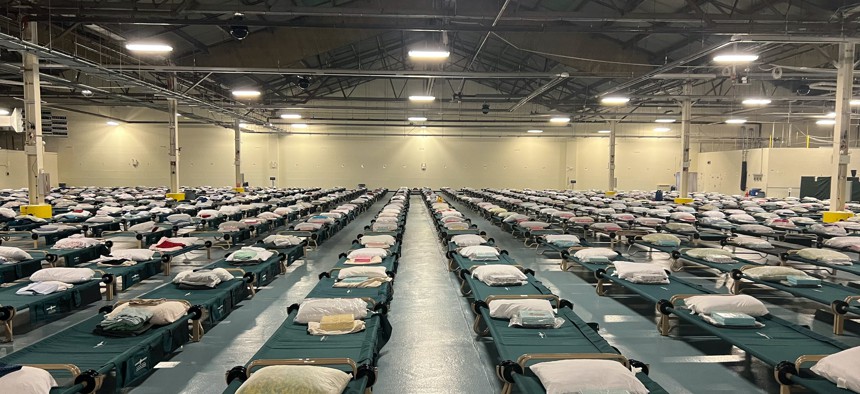Immigration
New migrant shelter is heated, local pol says, but privacy and other concerns remain
New York City Council members were offered tours of the new emergency relief center at the Brooklyn Cruise Terminal several days after it opened.

Cots are crowded up against each other in the Brooklyn Cruise Terminal being used to house migrants. Mayoral Photography Office
The New York City Council member who represents Red Hook got her first look on Wednesday at the neighborhood’s new temporary shelter that has been housing asylum seekers since this past weekend.
Council Member Alexa Avilés told City & State that the 1,000-bed shelter for single, adult male asylum-seekers set up inside the Brooklyn Cruise Terminal was heated when she toured it with a small group of other council members on Wednesday. Some migrants who were recently moved out of a midtown hotel shelter and into the Red Hook facility earlier this week promptly returned to the hotel, citing cold temperatures inside the barrack-style facility, along with other concerns.
But despite what she described as “fairly warm” temperatures she observed inside the facility on Wednesday, Avilés said that some of those other concerns that asylum-seekers raised about the new shelter – including cots lined up head-to-toe, “not ideal” access to bathroom facilities and a lack of privacy – remain. “I think what we heard and saw in initial videos taken by migrants themselves who were in the facility, everything was relatively corroborated,” Avilés said. “There’s no spacing between the cots. There’s no privacy, no space.”
Because they are heated by propane tanks, showers are in trailers outside the actual facility, meaning that people have to go outside in order to use the showers. And Avilés said that as outside temperatures continue to drop over the next few days, she wants to monitor the temperatures inside the facility to make sure that sufficient heat is still being provided.
Asked for comment on Avilés’ description of the facility, Fabien Levy, a spokesperson for the mayor, repeated a statement from earlier in the week, stressing that the cruise terminal facility provides the same services as every other humanitarian relief center in the city.
Avilés said that she was told on the tour that there were about 600 people staying in the cruise terminal shelter as of Wednesday. Levy did not respond to a question about how many asylum-seekers were staying there so far.
Single, adult male asylum-seekers who had been staying in a shelter at The Watson Hotel in midtown Manhattan started being moved out of the hotel this past weekend, in order to make room for migrant families to move into the hotel shelter. The single men have been moved into the new shelter inside the Brooklyn Cruise Terminal.
But a group of those men have refused to leave or returned to the hotel after seeing the cruise terminal shelter, however. They’ve cited reports of cold temperatures inside the cruise terminal, close sleeping quarters, a lack of privacy, and concerns about its more remote location. Some have slept outside the hotel after not being allowed back inside.
Representatives for City Hall have stressed repeatedly that the Red Hook facility is temperature controlled, provides designated storage space for every person and is meeting the needs of asylum-seekers. City Hall has also suggested that the protest by some asylum-seekers outside the midtown hotel shelter was initiated by outside activist groups and not the migrants themselves.
At an unrelated press conference on Wednesday, Mayor Eric Adams said that he checked out the complaints about a lack of heat and hot water, and said he found no evidence of them. “When I went to the Brooklyn Cruise Terminal – because you all know me, I like to go on the ground – I heard all of these complaints about no heat, no hot water, and no food. When I went there and saw that: clean bathrooms, heat, warm. Some people wearing shorts inside,” he said. “We did not hear one person there saying that they did not want to be there.”
On Wednesday, Manuel Castro, commissioner of the Mayor’s Office of Immigrant Affairs told City & State that mostly everyone from the Watson has moved on to the cruise terminal shelter. “Outside, it’s just a small group of people,” he said of the remaining asylum-seekers outside the hotel. Migrant families were set to move into the hotel on Wednesday, Castro said.
Adams echoed that the “overwhelming” number of people at the Watson have moved on to the Red Hook facility. “From my analysis, about 30 are still there, and I’m not even sure they’re migrants,” Adams said on Wednesday. “There are some agitators that really are doing a disservice to the migrants, and doing a disservice to the children and families who are moving into the hotels.”
More than 43,000 asylum-seekers have arrived in New York City since last spring, according to the mayor’s office. The city’s shelter population has surged, prompting the creation of dozens of emergency shelters to house migrants.
Adams has repeatedly asked state and federal officials for financial and other aid to help the city manage the influx of asylum-seekers. Adams has estimated that the cost of managing the crisis could reach as high as $2 billion, and has called on the federal assistance in particular to foot the bill.
On Wednesday, Gov. Kathy Hochul unveiled her state budget proposal, which included a plan to evenly split the total cost between the state, city and federal government.
Additional reporting by Jeff Coltin.

NEXT STORY: Eric Adams’ approval rating is underwater with New Yorkers
